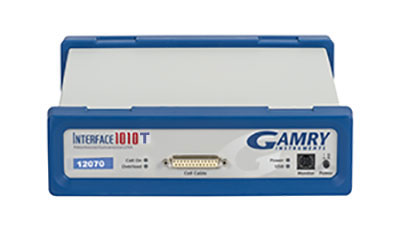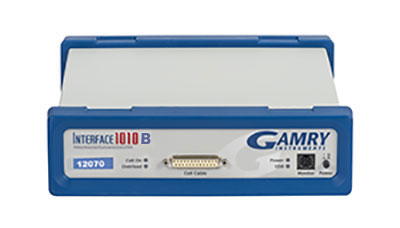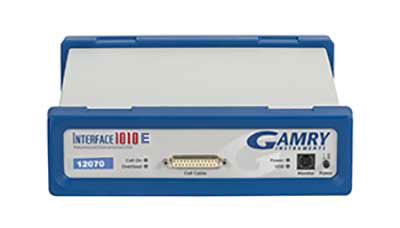Gamry Interface 1010 Potentiostats
Contact Sales for more information:
For sales in the United States
For International Sales and to find a local distributor
All experiments available in the Gamry Electrochemistry Laboratory Course are designed for use with a Gamry Potentiostat. Here are our suggestions for your course.
The Interface 1010T is a perfect potentiostat for use in undergraduate and graduate teaching labs. An entry-level potentiostat, the Interface 1010T is designed for undergraduate and graduate teaching labs providing all of the capabilities needed for getting students introduced to physical and analytical electrochemistry. It even provides for potentiostatic EIS up 20 kHz.
- Physical Electrochemistry – Techniques such as cyclic voltammetry, chronoamperometry, and chronopotentiometry.
- Pulse Voltammetry – Techniques such as differential pulse voltammetry, normal pulse voltammetry, Osteryoung square wave voltammetry, and associated stripping techniques.
- Electrochemical Impedance Spectroscopy – Potentiostatic EIS up to 20 kHz.
The Interface 1010T can be upgraded to a fully-featured Interface 1010E with an infield upgrade, allowing you to get a low-cost potentiostat for teaching purposes that can later be upgraded to a fully-capable research-grade potentiostat able to perform experiments for a wide variety of applications. Visit Gamry’s web site to view the specifications.

The Interface 1010B is a general purpose potentiostat that gives you the ability to run basic physical and electroanalytical techniques. The Interface 1010B with capabilities needed for techniques such as cyclic voltammetry, chronoamperometry, chronopotentiometry, pulse voltammetry and square wave voltammetry.
- Physical Electrochemistry – Techniques such as cyclic voltammetry, linear sweep voltammetry, chronoamperometry, chronopotentiometry, chronocoulometry, multistep chronoamperometry, and multistep chronopotentiometry.
- Pulse Voltammetry – Techniques such as differential pulse voltammetry, normal pulse voltammetry, reverse pulse voltammetry, Osteryoung square wave voltammetry, and associated stripping techniques such as anodic stripping voltammetry.
- DC Corrosion – Run standard DC corrosion tests such as polarization resistance, potentiodynamic, cyclic polarization, and galvanic corrosion in addition to a number of others.
- Electrochemical Energy – Test single-cells and stacks of various batteries, fuel cells or supercapacitors. Includes charge, discharge, cyclic charge-discharge techniques, potentiostatic, galvanostatic, self-discharge, leakage rate, and read cell voltage.
- eChemBasic – Software Toolkit that allows a developer to have basic control of potentiostat functions and the application of a user-defined signals. Simple potentiostatic and galvanostatic type experiments can be performed. Defining an array allows users to perform linear sweep or cyclic voltammetry.
- Electrochemical Impedance Spectroscopy – includes experimental scripts for potentiostatic, galvanostatic and hybrid impedance spectroscopy experiments in addition to single frequency techniques like Mott-Schottky.
The Interface 1010B can be upgraded to a fully-featured Interface 1010E with an infield upgrade. Visit Gamry’s web site to view the specifications.

The Interface 1010E is a full-featured potentiostat capable of performing all techniques, including electrochemical impedance spectroscopy.
- Physical Electrochemistry – Techniques such as cyclic voltammetry, chronoamperometry, and chronopotentiometry and derivatives of these techniques.
- Pulse Voltammetry – Techniques such as pulse voltammetry, square wave voltammetry, and associated stripping techniques such as anodic stripping voltammetry.
- DC Corrosion – Run standard DC corrosion tests such as polarization resistance, potentiodynamic, cyclic polarization, and galvanic corrosion in addition to a number of others.
- Electrochemical Energy – Test single-cells and stacks of various batteries, fuel cells or supercapacitors. Includes charge, discharge, cyclic charge-discharge techniques, potentiostatic, galvanostatic, self-discharge, leakage rate, and read cell voltage.
- Electrochemical Signal Analyzer – Designed specifically for the acquisition and analysis of time-dependent electrochemical noise signals. Cell voltage and current are continuously monitored at rates from 0.1 Hz to 1 kHz. A full featured set of analysis tools provides powerful analysis features such as statistical analysis, detrending, impedance spectra, and histogram analysis.
- Electrochemical Frequency Modulation – A non-destructive corrosion rate measurement technique. It allows for measurement of the corrosion rate without prior knowledge of the Tafel constants. In addition, the technique determines the Tafel constants and provides 2 internal validity checks.
- Critical Pitting Temperature – controls a Gamry Potentiostat, TDC4 Temperature Controller, and associated accessories to automatically measure the Critical Pitting Temperature of a material.
- Electrochemical Noise – A more general form of electrochemical noise testing. It is also an ECM8 Multiplexer compatible electrochemical noise software package.
- Electrochemical Impedance Spectroscopy – includes experimental scripts for potentiostatic, galvanostatic and hybrid impedance spectroscopy experiments in addition to single frequency techniques like Mott-Schottky. We also have our unique power-leveling multisine technique that improves signal-to-noise across the spectrum. On the analysis side, it provides tools for fitting spectra to equivalent circuit models, Kramers-Kronig transform for data validation and a graphical model editor. Our software even includes a script for EIS simulation.
- eChemDC Toolkit – contains all of the capabilities of the eChemBasic and further extends these capabilities by adding advanced signals and data acquisition modes to simplify implementing experiments like cyclic voltammetry, pulse voltammetry, and dynamic DC corrosion techniques. Also includes more advanced stop tests, particularly useful in fast experiments.
- eChemAC – Includes full capabilities of eChemDC Toolkit plus allows electrochemical impedance spectroscopy (EIS) and EFM experiments.

